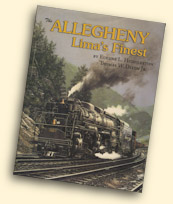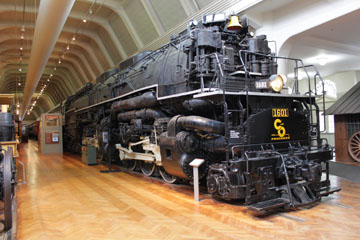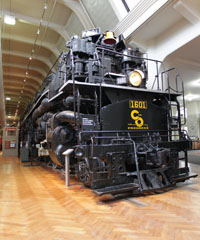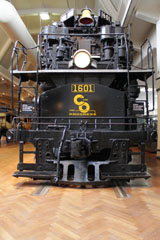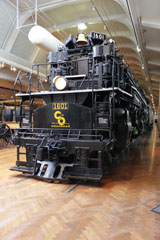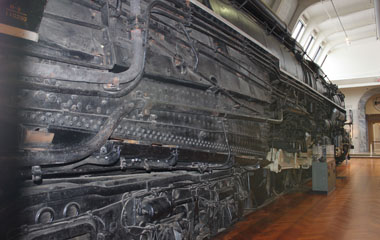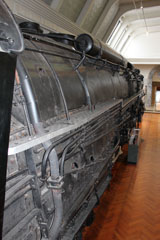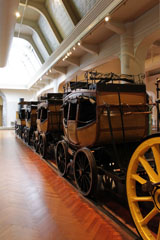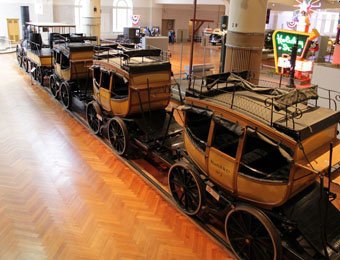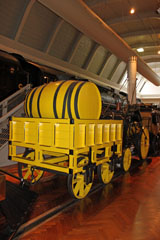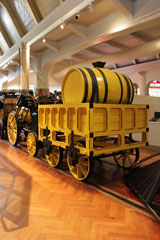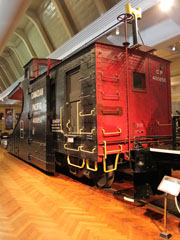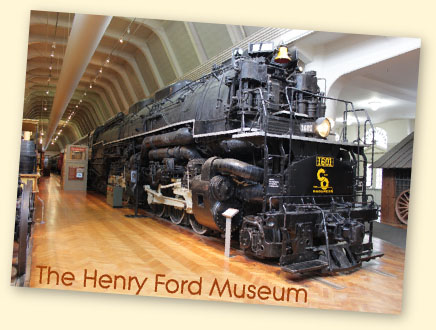

The Henry Ford Museum is located in Dearborn, MI, a suburb of Detroit. It is part of the much larger Edison Institute, which also includes Greenfield Village.
This twelve acre site encompasses an eclectic collection of antique machinery, automobiles, locomotives, aircraft and famous homes, including John F. Kennedy's presidential limousine, Abraham Lincoln's chair from Ford's Theatre where he was assassinated in 1865, Thomas Edison's laboratory and the Wright Brothers' bicycle shop, which was moved there from Dayton, OH.
There is also a transportation system providing rides on a horse-drawn omnibus, a 1931 Model AA bus, original Ford Model T automobiles and historic steam locomotives. The operating steam locomotives include the "Torch Lake", an 1873 0-6-4 Mason Bogie which is one of the oldest operating steam locomotives in the US, and the "Edison", a Davenport built 0-4-0 rebuilt by Ford into a 4-4-0.
It was winter when I visited the Institute so,
unfortunately, none of the steam locomotives was operating.

The Allegheny has perhaps one of the most distinctive front ends of any steam locomotive in the US. The pilot-mounted headlight and flying pumps are something of a C&O design motif on large articulated power (see, for example CO H-6 2-6-6-2 #1309 on the B&O Museum Yard and Car Shop page of this website).
The angular pilot shield is unique, although it was also fitted to the VGN AGs, but I have never seen photographs of operational Alleghenies sporting the "C AND O FOR PROGRESS" banner on #1601's shield here.
#1601 was one of the first ten 2-6-6-6 locomotives built for the Chesapeake & Ohio by Lima in 1941 (#1600-#1609). Ten more were ordered in 1942 (#1601-#1619), and two further orders were delivered in 1944 (#1620-#1629 and #1630-#1644) as well as one in 1945 (#1645-#1659) bringing the total roster to sixty.
Designed to work over the Allegheny Mountains on C&O's Clifton Forge Division, the locomotives were named "Alleghenies", and #1601 is one of only two to survive. The second is #1604 (you can see photos of it on the B&O Museum Yard and Car Shop page of this website).
The Alleghenies usually doubled on the most challenging part of the grade, one at the front and one at the back, typically pulling one hundred car
coal trains eastbound from Hinton, WV, to the top of the grade at Alleghany (a local spelling). With a
loaded coal car nominally weighing 100,000 lbs, that totals a staggering 10,000,000 lbs or nearly 4,500
tons!
The Virginian Railway also ordered an almost identical build of eight locomotives in 1945 (#900-#907). They were classed AG (articulated Gs) and known as "Blue Ridges". Unfortunately, none of the VGN AGs have survived.
#1601 was donated to the museum in 1956. Although it has been suggested #1601 was steamed to Dearborn, Eugene Huddleston's Allegheny, Lima's Finest, records it was "not in a shape to be fired up" (p.242) while in storage on a roundhouse radial spur at Handley that year. He records it was sent from there to be cosmetically restored at C&O's Huntington Shops prior to moving to the museum, so it is unlikely it travelled under its own power.
The locomotive is well preserved in the climate controlled museum, if a little dusty (I didn't see any evidence of leaking lubricating oil!).
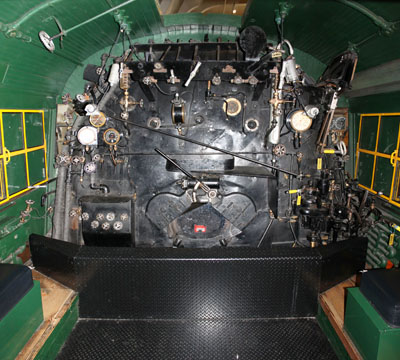
The backhead of #1601 has been pretty well restored, although the steel flooring and barrier at shoe-level conceals the coal shute and grate rockers. You get a better view of CO #1604's backhead on the B&O Museum Yard and Car Shop page of this website.
The four high pressure cylinders are 22½" x 33" and its drivers 67". It has a 9' x 15' firebox and 135 sq ft grate. With a 9' 10" combustion chamber and 23' between the cover sheets, the boiler was some 48' long. Total heating surface, including firebox, syphons, combustion chamber, forty-eight tubes and two hundred and seventy-eight flues was 7,240 sq ft. The super heating surface was a further 3,186 sq ft. Operating at a boiler pressure of 260 psi, the Allegheny delivered 110,200 lbs tractive effort.
The locomotives had a relatively short operating life, and started going into storage in 1952 as diesels began to take over on the system. The last fires on an Allegheny (#1647 and #1653) were dropped at the Hinton engine terminal on 27th July 1956.
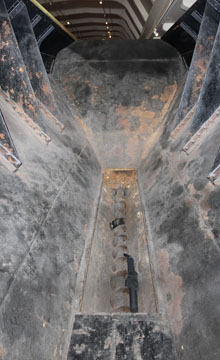
Above, the tender coal screw. Stokers were provided by the Standard Stoker Company.
The tender frames were one piece water bottom type made by General Steel Castings. They were the largest tenders used on the C&O with a 25,000 gallon water and 25 ton coal capacity.
To keep the length of locomotive and tender within the limit imposed by existing turntables on the C&O system, the rear of the tender was made higher, placing additional weight there. As a result, it had an eight axle Buckeye trailing truck and six axle Buckeye leading truck.

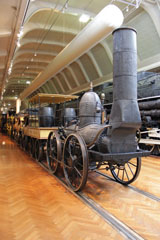
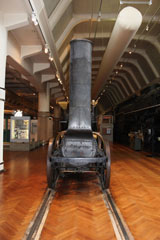

The "DeWitt Clinton" is a replica built in 1893 by New York Central for that year's Chicago Worlds Fair. It appeared at the 1927 Fair of the Iron Horse in Maryland, and was used for promotional purposes by the NYC until loaned to the museum in 1935. It appeared at the 1933-34 Chicago World's fair, 1939-1940 New York World's Fair and the Chicago Railroad Fair in 1948-1949.
The original was designed by John B. Jervis and built by David Matthew at the West Point Foundry for the Mohawk & Hudson in 1831. It was the M&H's first locomotive (until then, trains had been pulled on the sixteen mile line from Albany to Schenectady by horses), the first to operate in the state of New York and only the fourth steam locomotive built in the US. Shipped to Albany by river boat, it made its debut at a celebration to mark the opening of steam operations on the line.
Named after the US Senator and sixth Governor of New York who was largely responsible for construction of the Erie Canal, the original locomotive apparently weighed some 6,750 lbs, had 54" drivers and 5½" x 16" cylinders.
Designed to burn anthracite coal, the 0-4-0 apparently "drew" badly and did not produce sufficient draft to develop the heat necessary to power the engine. It was consequently converted to burn wood.
The replica at the museum is displayed much as it would have appeared at its inauguration on
9th August 1831, pulling a car carrying water barrels and three passenger carriages made of stagecoach bodies attached to railroad trucks. These were standard passenger conveyances of the day, although soon superseded by purpose built passenger carriages.



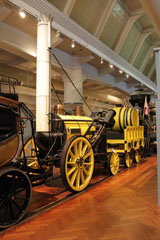
In 1929, Ford had this replica of the
"Rocket" built by Robert Stephenson & Co., in Darlington, England at a cost of $11,913.60.
The greatly altered original, built in 1829, is now on display in the Science Museum in London, England.
The original 0-2-2 "Rocket" won Stephenson £163,500 at the three day Rainhill trials, set up by the Liverpool & Manchester Railway to determine the best motive power to employ on the railroad. Ten locomotives were entered, but only five competed.
The "Rocket" was the only one to complete the trials, starting on 6th October 1829, averaging 12 mph and achieving a top speed of 30 mph. Stephenson was consequently awarded the contract to build locomotives for the Liverpool & Manchester, and the horizontal boiler and rear firebox, multiple boiler flues and directly connected driving rods pioneered by the "Rocket" were employed on virtually every subsequent steam locomotive.
You can see a 1931 Stephenson Company replica "Rocket" on the Science & Industry Museum Chicago page of this website.

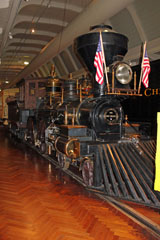
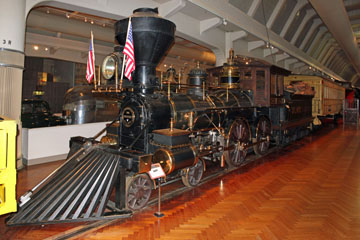
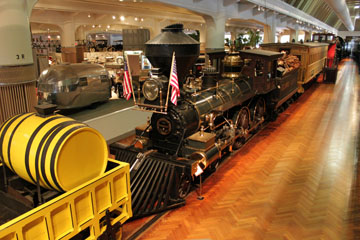
This American type
(4-4-0) locomotive was built at a cost of $8,200 by the Rogers Locomotive Works in 1858 for the Atlantic & Gulf Railroad to work at one of its logging plants. It was one of the first locomotives bought by the railroad and was named "Satilla" after the river of that name.
Chartered in 1856, the Atlantic & Gulf crossed southern Georgia from Thomasville to Screven, where it connected with the Savannah, Albany & Gulf Railroad on to Savannah. The two railroads were consolidated in 1863.
The "Satilla" was sold to the Savannah, Florida & Western Railway in 1879 and, ten years later, to the J. J. McDonough Lumber Co.
Renumbered #110, it worked for the next thirty-five years at McDonoughs until it was purchased by Ford in 1924. He then renamed it "Sam Hill" in honour of an engineer who had worked on a Michigan Central express that passed through Dearborn when he was a boy. Ford loaned the locomotive to appear at the 1927 Fair of the Iron Horse in Maryland. He then donated it to the Edison Institute in 1928, where it was renamed "The President" in honour of President Herbert Hoover when it was chosen to haul a set of specially built cars to the opening of the Institute.
The Edison Institute, of which the Henry Ford Museum forms a part, was dedicated by President Hoover on 21st October 1929 on the 50th anniversary of Thomas Edison's invention of the incandescent light bulb. Amongst luminaries in attendance were Marie Curie, John D. Rockefeller and Orville Wright, and Hoover's dedication speech was broadcast on national radio, with listeners encouraged to turn off their electric lights until the switch was flipped at the new museum.
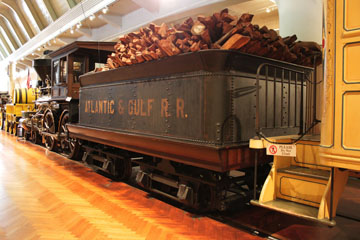
According to the information panel displayed with #3 at the museum, the locomotive purportedly weighs 90,000 lbs, but this is hard to credit, as it would be remarkably heavy for a logging plant, as well as for pre Civil War Southern railroads. It is more likely to weigh c.44,000 lbs (see notes on the relevant steamlocomotive.info page).
Built with 60" drivers, these were subsequently reduced to 55" and then to 53". the engine's cylinders are 13" x 20". A wood burner operating at a boiler pressure of 125 psi, #3 delivered 7,453 lbs tractive effort.

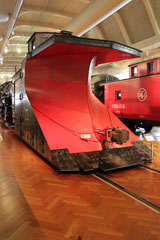
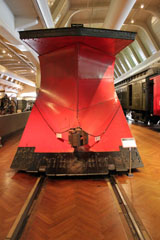
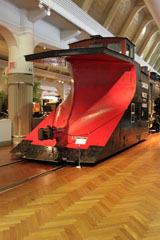
Twenty ton Canadian Pacific Snow Plow #400850 is one of thirty-six built by the railroad's Angus Shops in Montreal between 1920 and 1929.
#400850 is a wedge snow plow. It was designed to clear snow from single tracks, throwing snow off to each side as it was pushed forward by one or two locomotives attached to the rear. It worked in Canada and New England from 1923 to 1990, when it was donated to the museum by the Canadian Pacific.
The movable "wings" (clamped back in the two lower views of #400850) could be opened to extend the plow's operating width from 10' to 16' across.
Snow plows were essential parts of the maintenance of way equipment for railroads operating in the snow bound north.
You can see other wedge plows on the Lake Superior Railroad Museum page of this website and the Railroad Museum of Pennsylvania Train Shed page.


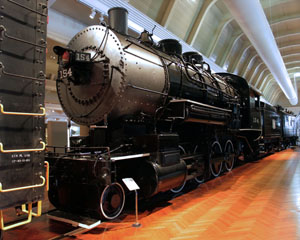
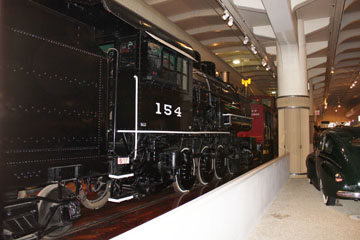
This 2-8-0 Consolidation type locomotive was built by Baldwin in 1909 for the Bessemer & Lake Erie Railroad.
What would eventually become the Bessemer & Lake Erie route started with the Shenango & Allegheny Railroad in 1869. The Pittsburgh, Bessemer & Lake Erie Railroad was then founded in 1897 by Andrew Carnegie.
Created from a set of smaller railroad companies including the Shenango & Allegheny, it was renamed the Bessemer & Lake Erie
in 1900 and was then acquired by US Steel when that company bought Carnegie Steel in 1901 as part of a major consolidation.
In 1988, the Bessemer & Lake Erie became part of Transtar Inc., a privately owned transportation holding company. In 2001, the railroad then became part of
the Great Lakes Transportation holding company and, in 2004, joined the
Canadian National Railway as part of its larger purchase of Great Lakes Transportation.
Four Consolidation locomotives were built for the Bessemer & Lake Erie by the Pittsburgh Locomotive Works in 1900,
and #154 was one of six more acquired in 1909 from Baldwin. The primary business of the Bessemer & Lake Erie was hauling heavy tonnages of iron ore and coal between the industrial area of Pittsburgh, PA, and the Lake Erie ports of Conneaut, OH, and Erie, PA.
When originally built, this class of "drag" Consolidation was the heaviest and most powerful locomotive in the world. They were specifically designed to tackle the heavy grade between Conneaut, OH, and Albion, PA.
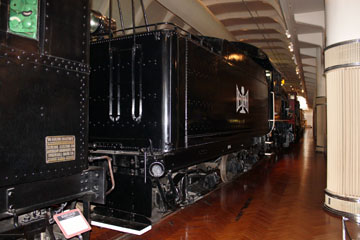
#154 spent its forty-four year operating life on the Bessemer & Lake Erie before retiring in 1953 and being held for potential donation to a museum. It waited a long time, however, as it was not until 1984 that it was donated to the Illinois Railway Museum in Union, IL. Then, in 1989, it was traded for Detroit, Toledo & Ironton #16 (you can see DTI #16 on the Illinois Railway Museum Train Shed page of this website).
#154 weighs 253,960 lbs. It has 52" drivers and
24" x 32" cylinders. Operating at 220 psi, it delivered 63,829 lbs tractive effort.

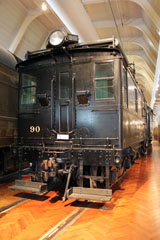
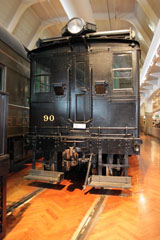
From 1925 to 1930, a partnership of Alco, General Electric and Ingersoll Rand produced a series of oil-electric and diesel-electric locomotives.
You can see the first of the these units built in 1925, CNJ #1000, on the B&O Museum Roundhouse page of this website.
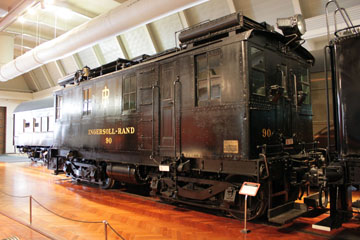
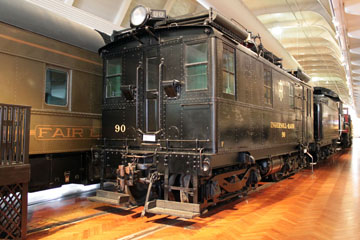
#90 is the sixteenth unit produced by the partnership. Alco issued orders and provided the car bodies to GE at its Erie, PA, works. Ingersoll-
Rand produced the engines in Phillipsburg, NJ, and shipped them to GE, which then delivered the completed units back to Ingersoll-Rand.
Built in 1926, #90's 6 cylinder diesel-electric motor powered four 95 hp traction motors, one on each axle, delivering 36,000 lbs tractive effort. Used as a promotional demonstrator, switching in Ingersoll-Rand's Phillipsburg works until the late 1960s, it was donated to the museum in 1970 and went on display in 1984.

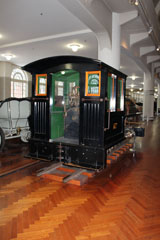
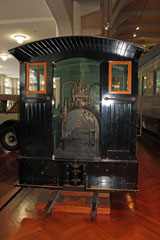


#7 is a 2' narrow gauge 0-4-0T (Tank) locomotive built by the Davenport Locomotive Works of Davenport, IA, in 1898. It worked for Michigan's Wayne County Road Commission from 1922 to 1927. A coal burner, it has 7" x 12" cylinders and 24" drivers. It operated at a boiler pressure of 160 psi delivering 3,332 lbs tractive effort.
You can see photos of other Davenport steam locomotives on the Travel Town page of this website, the Savannah Roundhouse Railroad Museum page and the Ogden Union Station page
Related Links:
Location of the Henry Ford Museum
Send a comment or query, or request permission to re-use an image.
Eugene L. Huddleston and Thomas W. Dixon Jr. have written an excellent book on C&O's H-8, The Allegheny, Lima's Finest, published by Hundman in 1984 (click on the cover to search for this book on Bookfinder.com).
